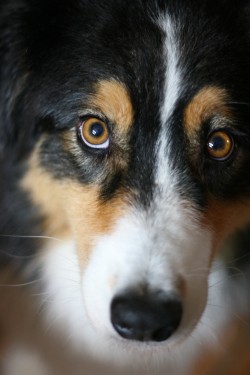Rev, February 2015

Eye exams are performed on all breeds of dog to screen for hereditary eye disease. Australian Shepherds should be examined as young puppies (no later than 8 weeks and preferably by 6 weeks) and annually thereafter until at least ten years of age. The most common eye diseases in the breed are cataracts, distichiaisis, persistent pupilary membrane, and iris coloboma, with Progressive Rod Cone Degeneration (PRCD), a form of progressive retinal atrophy(PRA), Collie Eye Anomaly (CEA), Canine Multifocal Retinopathy (CMR), and glaucoma have been seen but are rare. Merle ocular dysgenesis also occurs, but since we know this is the result of breeding two merles together the source of the problem is obvious and easy to avoid.
Young Aussies (under 8 weeks) should be screened to check for congenital defects related to CEA, iris coloboma and PPM. It is vital that all Aussie pups get an early screening because as the pigment develops in the back of the eye the CEA defects may cease to be visible to the examiner. These dogs are referred to as “masked affected.” This can occur as early as 6-7 weeks.
Eye diseases you may encounter in Australian Shepherds:
Cataract–the most common eye disease in Aussies. Hereditary forms are posterior (back of the lens) and bilateral (both eyes) but may not start at the same time in each eye. The disease can be blinding. Aussies usually are diagnosed between two and five years of age, but some exhibit hereditary cataracts earlier or later, even into old age. Hereditary cataracts do not occur in young Aussie puppies. There is more than one type of hereditary cataract in Aussies. The most common type is associated with a dominant mutation of a gene called HSF4. There is a DNA test available for this mutation. Mode of inheritance for other types is not known at this time.
Persistent pupilary membrane (PPM) – the pupilary membrane is a fetal structure that covers the pupil before birth. When parts of it fail to go away it is termed PPM. PPM may be observed in young puppies but frequently is absent a few weeks or months later. Sometimes, however, it will persist. Most PPMs are attached only to the iris. Some PPMs form sheets of tissue, or have one end attached to the lens or cornea. The iris-to-iris forms will pass the ACVO (US) exams but those which attach to the lens and cornea do not because they can be associated with opacities of those tissues which may be blinding. A dog with iris sheet, iris-to-lens or iris-to-cornea PPM should not be bred.
Distichiasis–one or more abnormal eyelashes that grow toward the eye instead of away from it. Often these lashes are benign, but they sometimes cause painful abrasion to the cornea and may require surgical correction. They can occur at any age and may come and go. Mode of inheritance is not known.
Iris Coloboma—a section of iris which failed to develop. Almost all affected dogs are merle. A large coloboma will prevent the iris from dilating and contracting properly resulting in some discomfort and difficulty in bright light. The condition is congenital (present at birth). Mode of inheritance is unknown.
Progressive Rod Cone Degneration (PRCD) – the most common type of Progressive Retinal Atrophy (PRA) found in dogs. Retinal damage accumulates until the dog is blind. A DNA test is available. This disease can be mistaken for another disease and certain types of traumatic retinal damage can be misdiagnosed as some form of PRA. If you have a dog diagnosed with any type of PRA upon examination, it would be wise to verify with a DNA test. Note: Other types of PRA do occasionally occur in Aussies and the PRCD test will not identify them.
Collie Eye Anomaly (CEA)–a complex of congenital defects including choroidal hypoplasia, also called chorioretinal dysplasia – a thinning of the vascular tissue within the eye), optic disc coloboma/staphloma – incomplete development of the optic nerve where it enters the eye, and retinal dysplasia or detachment – sections of retina, the vision reception tissue, that are not properly attached to the wall of the eye. Some dogs are only mildly affected, but those with large colobomas or retinal detachment will be blind. The disease is bilateral (both eyes) but defects observed can vary from one eye to the other. The disease is recessive; if a dog has it both parents carried it. There is a DNA test available for this disease. Misdiagnosis of CEA disease is possible. If you have reason to doubt a CEA diagnosis, have the DNA test done to verify. Dogs must be examined as young puppies (under eight weeks of age to be sure of identifying all affected individuals.
Canine Multifocal Retinopathy (CMR) – blister-like defects in the retina which can be detected by 4 months of age. It may gradually progress or may go away. Diagnosis by exam can be difficult; CMR may be described as retinal dysplasia or retinal folds, both of which are reported in Aussies. In rare instances the disease can impact vision; should this occur the dog should not be bred. However, most cases are noted as “breeder option” on US eye exams, though may disqualify a dog from breeding in some countries. A DNA test is available. Dogs with CMR and normal vision may be bred but should only be bred to mates that have tested clear. Owners of Aussies who have been diagnosed with either retinal dysplasia or retinal folds should consider having their dogs DNA tested for CMR.
Glaucoma – a build-up of pressure within the eye due to blocked fluid ducts. The pressure can damage the retina leading to blindness. The disease is painful if not treated. It is rare in Aussies and are not clearly established as inherited (it can be secondary to other things, including continued steroid use.) That said, it is inadvisable to breed affected individuals.
